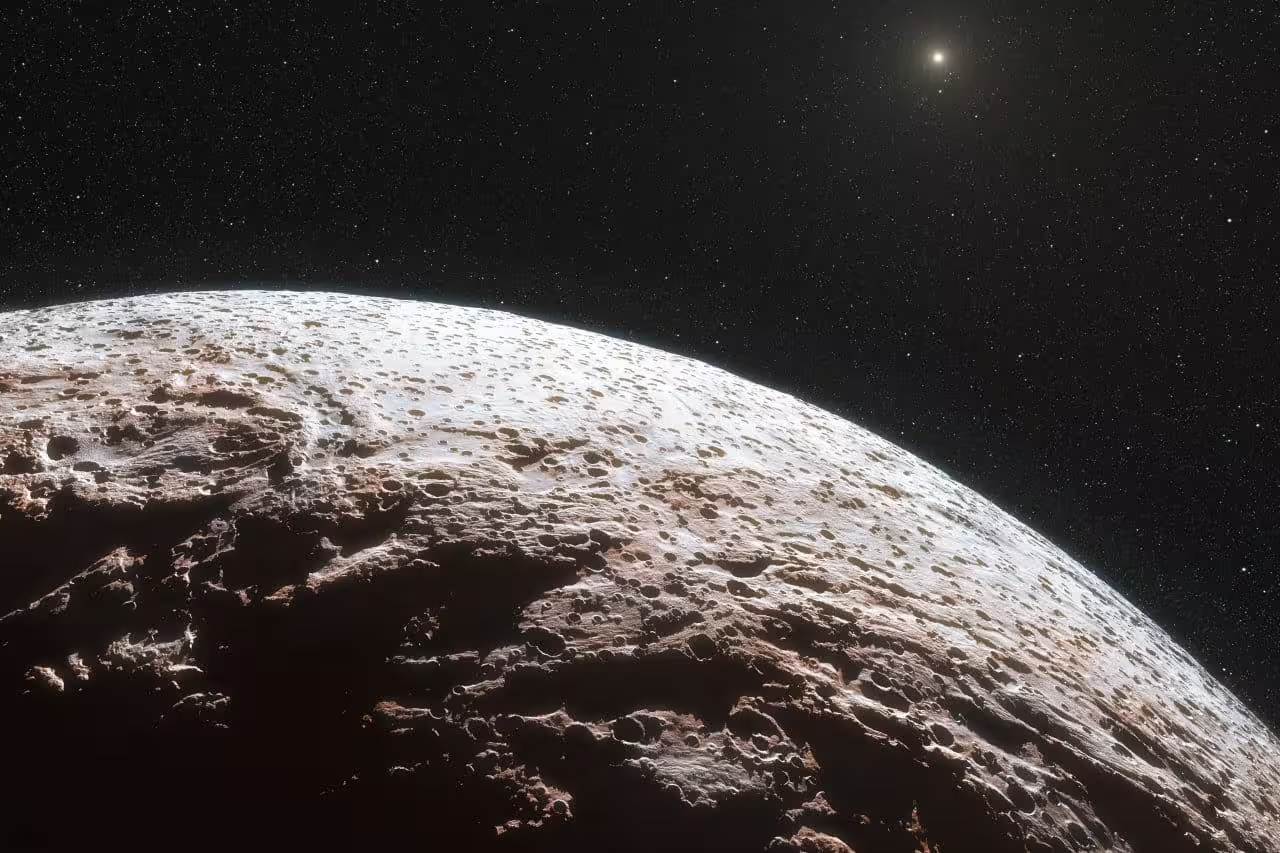The dwarf planet Makemake, whose orbit lies outside Neptune’s, may have an active ice volcano on its surface. This was demonstrated by sharp temperature fluctuations recorded by one of the instruments of the James Webb orbital telescope. Makemake is the third largest object in the Kuiper Belt. The dwarf planet is believed to be too small and cold to support volcanic activity. If the hypothesis is confirmed, it would be an unprecedented event for trans-Neptunian objects, and the discovery is likely to change the way scientists think about the formation of such distant worlds.
makeup — dwarf planetIt is one of the largest and brightest objects in the Kuiper Belt, which is about 45 times farther from the Sun than Earth. In 2007, the Spitzer Infrared Space Telescope helped astronomers measure Makemake’s diameter and albedo. According to these measurements, the diameter of the dwarf planet is approximately 1,500 kilometers and its geometric albedo is 0.8.
Makemake’s surface is mostly covered with methane ice and products that remain when methane evaporates under the influence of sunlight (for example, tholin – a mixture of organic copolymers). In 2024, a group of geochemists from the United States conducted an analysis of the methane isotopic composition of the dwarf planet using the James Webb space telescope. By examining the relative content of various isotopes in a substance, scientists obtain information about its formation and evolution characteristics.
Results of analysis of the ratio of different hydrogen isotopes in methane showed evidence of geothermal in the Makemake subsurface. That is, it turns out that methane on the surface of the dwarf planet has signs of geochemical origin in hot conditions, for example, due to the influence of volcanoes. In this respect, it is different from the methane found in comets.
In 2015, the New Horizons spacecraft discovered similar signs on the surface of another dwarf planet, Pluto, namely traces of cryovolcano activity, which was then no longer active. Cryovolcanoes are a type of volcanism in low temperature conditions. Instead of molten rocks, they release water, ammonia and methane, both in liquid (cryolava) and gaseous form.
Also read – Scientists have identified the name of an organism that can live in Martian conditions.
Similar traces were later found on another dwarf planet, Ceres. At the same time, scientists hypothesized that cryovolcanism was not a rare phenomenon in trans-Neptunian objects. However, it has not yet been possible to detect an active volcano on the dwarf planet.
Before the New Horizons mission, experts believed that Makemake was too cold for volcanic activity because it is located far from the Sun (5.6-7.9 billion kilometers away). The equilibrium temperature here is approximately minus 244 degrees Celsius. It was also believed that the cosmic body was not large enough to trigger this process.
A team of astronomers from Hungary, led by Xab Kiss ( Csaba Kiss ) Evidence has been obtained from the Konkoya observatory of volcanic activity that is probably currently occurring (at the time of this writing) in Makemak.
Scientists recorded thermal radiation in the infrared part of the spectrum (in the range of 18-25 micrometers, μm), corresponding to a temperature of minus 120 degrees Celsius, which is much higher than the average temperature of Makemake, which is minus 244. degree. Scientists made this discovery using the MIRI spectrograph built on James Webb.
Researchers explained the temperature changes by two possible reasons. The first of these, and the most likely, according to the study’s authors, is the activity of a cryovolcano. The second is the fine-grained powder surrounding Makemake.
If the cause of temperature fluctuations is cryovolcanic activity, then the dwarf planet has an active cryovolcano on its surface, under which a liquid ocean could splash. It has remained liquid since its formation, most likely due to latent heat within the dwarf planet.
According to Kiss, the ocean probably does not consist of the water we are used to, but contains impurities of ammonia and salts of other substances. In addition, the cryovolcano itself may appear to the observer completely different from what astronomers are accustomed to seeing in other objects. For example, there may be a crack in the crust through which methane is released to the surface.
Also read – Scientists discovered why soil on Mars forms a hard crust
Temperature changes can also be caused by fine-grained carbon powder heated by the Sun, which can wrap Makemake into a thin ring. It is even possible that the temperature anomaly results from two of these processes that are somehow linked: for example, a cryovolcano ejects fine-grained material into space.
Ultimately, it is necessary to make longer observations of Makemake to understand the issue. In the study published on the website of the electronic preprint archive arXiv.org The authors noted that they examined the dwarf planet for less than an hour.
In any case, it does not matter whether the cause of the temperature change is a cryovolcano or fine-grained dust: both options will be sensational. First, scientists have never discovered a ring of fine-grained dust around dwarf planets. Second, an active cryovolcano in the Kuiper belt is a unique phenomenon in itself.













